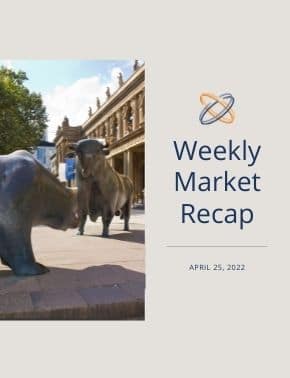Week in Review
Equity Markets:
The S&P 500 ended the week lower by 2.7%, and the NASDAQ continued to disappoint, down 3.8%. The equity markets continue to battle two major headwinds: Fed Policy and implications with interest rates, and the conflict in Ukraine. Tensions in Ukraine heated up after a slight de-escalation. Investors have concerns about the impact on already high levels of inflation and the global economic risks that can result from a lengthy conflict in Ukraine.
Earnings season is almost a quarter of the way through. So far, 79% of companies have beaten earnings expectations. This is slightly better than the 5-yr average of 77%, according to FactSet.
Fixed Income Markets:
The 10-yr treasury ended the week at 1.9%. The past few weeks the yield curve has been in a steepening trend after the brief inversion, but it reversed this week as we saw shorter-term rates outpace the long end of the curve. This is likely due to investors’ beliefs the Fed will take an aggressive stance at their next meeting in May.
Members of the Fed spoke last week, and reaffirmed their aggressive stance on inflation. The markets fully expect a 50-basis point increase in the Fed fund’s rate at the FOMC’s May 4th meeting. The markets are pricing in an eventual Fed Fund’s rate of 2.5%; much higher than the .25-.5% target currently.
Economic:
Housing numbers continued to show softening. The homebuilders confidence index fell 2 points in April, as builders have seen a decrease in buyer traffic. Mortgage demand also fell the prior week, and is half of what it was a year ago, as the 30-yr mortgage rate topped 5%.
Preliminary PMI numbers were mixed. Manufacturing PMI, from S&P Global, surprised to the upside while service PMI unexpectedly came in lower. Both numbers still remain in expansion territory but are showing a slowing of growth.
Looking Ahead
Equity Markets:
Earnings will take over headlines this week as many of the market’s behemoths report. These include Apple, Amazon, Microsoft and Google’s parent company, Alphabet. Earnings season has been positive so far, but many companies have ratcheted back expectations going forward. Earnings growth is likely to be lower for the year than analysts targeted just a few weeks ago. While earnings growth may compress, earnings are still expected to grow.
Investors should expect continued volatility. Global recessionary risks have increased according to Bank of America’s global fund manager survey. The shift away from the war in Ukraine is likely due to the IMF and world bank decreasing their global growth expectations for 2022 and 2023. We think investors should take a hard look at their portfolio and risk exposures to ensure they are able to sustain the likely continuance of volatility. We believe broad diversification with the proper allocation to diversified equities, as well as high quality fixed income, is the best approach for an investor to withstand uncertain times like we are experiencing today.
Fixed Income Markets:
The markets expectation for rates in 2022 is assuming the Fed stays very aggressive. It is our stance this is not completely negative for the bond market. The Fed has the ability to slow the pace of hikes if they see meaningful economic weakness and/or slowing inflationary pressures with their new data-dependent view of policy making. Anything short of expectations will likely lead to a rally in bond prices, driving yields lower.
As rates settle into the 2.5-3.25% range, where we believe they will stay for the next 12-18 months before moving lower, opportunities in the bond market are becoming more attractive. The downside protection of treasuries, relative to equity market risk, and more attractive yield for income investors, are both positive for the bond market going forward.
Economic:
With the quiet period before the May 4th FOMC meeting, economic numbers will be closely watched. The 1st of 3 first quarter GDP readings will be released. The Conference Board’s Consumer Confidence Report and the University of Michigan’s Consumer Sentiment Index will give insight into how consumers are dealing with levels of inflation and the concerns around the health of the global economy. March personal income and spending will also garner attention.
Important Disclosures:
Investment Advisory Services offered through Krilogy®, an SEC Registered Investment Advisor. Please review all prospectuses and Krilogy’s Form ADV 2A carefully prior to investing. This is neither an offer to sell nor a solicitation of an offer to buy the securities described herein. An offering is made only by a prospectus to individuals who meet minimum suitability requirements.
All expressions of opinion are subject to change. This information is distributed for educational purposes only, and it is not to be construed as an offer, solicitation, recommendation, or endorsement of any particular security, products, or services.
Diversification does not eliminate the risk of market loss. Investments involve risk and unless otherwise stated, are not guaranteed. Investors should understand the risks involved of owning investments, including interest rate risk, credit risk and market risk. Investment risks include loss of principal and fluctuating value. There is no guarantee an investing strategy will be successful. Past performance is not a guarantee of future results. Indices are not available for direct investment; therefore, their performance does not reflect the expenses associated with the management of an actual portfolio. The S&P data is provided by Standard & Poor’s Index Services Group.
Services and products offered through Krilogy® are not insured and may lose value. Be sure to first consult with a qualified financial advisor and/or tax professional before implementing any strategy discussed herein.




















